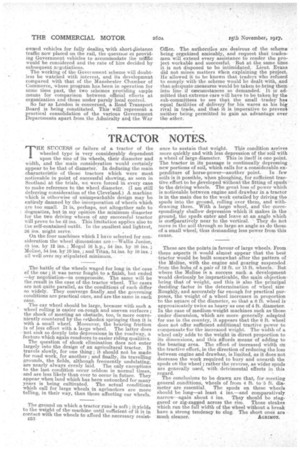TRACTOR NOTES.
Page 18

If you've noticed an error in this article please click here to report it so we can fix it.
THE SUCCESS or failure of a tractor of the wheeled type is very considerably dependent upon the size of its wheels their diameter and width, and the main consideration would certainly appear to be that of diameter: In deducing the main characteristic of those tractors Which were most noticeable in point of successful showing, as seen in Scotland at the trials. we were forced in every case to make reference to the wheel diameter. (I am still deferring consideration of the Cleveland.) A machine which is otherwise of unimpeachable design may be entirely damned by the incorporation of wheels which are too small. It is, perhaps, not altogether safe to 1 dogmatize, but in my opinion the minimum diameter for the two driving wheels of any successful tractor will prove to be 42 ins. Thin limitation applies also to the self-contained outfit. In the smallest and lightest, 36 ins, might serve. .
On the four machines which I have selected for consideration the wheel dimensions are :—Wallis Junior, 48 ins. by 12 ins. ; Mogul 16 h.p., 54 ins. by 10 ins. ; Moline, 54 iris. by,10 ins. ; and Titan, 54 ins. by 10 ins. ; all well over My stipulated minimuin.
The battle of the wheels waged for long in the-case of the car ; it was never fought to a finish, but ended —by negotiation—in coinpromiSe. The same will be the result in the case of the tractor wheel. The cases are not quite parallel, as the conditionS of each differ so widely. They converge finally and the governing conditions are practical ones, and are the same in each case.
The car wheel should be large, because with such a wheel rolling is easier on-rough and uneven surfaces ; the shock of meeting an obstacle, too, 'is more conveniently countered by the orthodox springing than it is with a small wheel. Moreover, the bearing friction is of less effect with a large wheel. The latter does not sink so deeplyinto depressions in the roadway, a feature which again conduces to easier riding qualities. The question of shock elimination does not enter largely into the design of an agricultural tractor. It travels slowly, for one thing ; it should not be made for road work, for another ; and finally, its travelling grounds, the fields, although freauently undulating, are nearly always evenly laid. The only exceptions to the last condition occur seldom in normal times, and are less likely than ever to ocenr in future. They appear when land which has been untouched for many years is being cultivated. The actual conditions which call for large wheels in agrimotors are more telling, in their way, than those affecting car wheels.
The ground on which a tractor runs" is soft; it yields to the weight of the machine until sufficient of it is in contact with the wheels to afford the necessary resist e53 ance to sustain that weight. This condition arrives more quickly and with less depression of the soil with a wheel of large diameter. This in itself is one point. The tractor in its passage is continually depressing new portions of soil, which calls for a considerable expenditure of horse-power—another point. In few soils is it possible, when ploughing, for sufficient tractive effort to be eleveloped Without the fitting of spuds to the driving wheels. The great loss of power which is noticeable between engine and drawbar in a tractor is in the main due to the work entailed by driving the spuds into the ground, rolling over them, and withdrawing them. With a large wheel, and the correspondingly shallow depression which it makes in the ground, the spuds enter and leave at an angle which is ceneparatively near to the vertical. They do not move in the soil through so large an angle as do those of a small wheel, thus dethan ding less power from this cause.
These are the points in favour-of large wheels. From these aapects it would almost appear that the best • tractor would be built somewhat after the pattern of the Moline, with the engine and gearing suspended . from the hubs of a pair of 12 ft. or 15 ft. wheels..Bat i where the Moline s a success such a development would obviously be impracticable, the main objection• being that of weight, and this is also the principal decidingfactor in the determination of wheel size Roughly, and accurately far enough for practical purposes, the weight of a wheel increases in proportion to the square of the diameter, so that a 6 ft. wheel is approximately twice as heavy as one of 4 ft. diameter. In the case of medium-weight machines such as those under discussion, which are more generally adapted for use in the country, it appears that the 6 ft. wheel does not offer sufficient additional tractive power to compensate 'for the increased weight. The width of a wheel only adds to the weight in. direct proportion to its dimensions, and this affords means of adding to the bearing area. The effect of increased width on the tractive effort, in the direction of reducing the loss between engine and drawbar, is limited, as it does not decrease the work required to bury and unearth the spuds on the wheel ; rather the reverse, as wider spuds are generally used, with detrimental effects in this regard.
The conclusions to be drawn are that, for 'meeting general .conditions, Wheels of from 4 ft. to •5 ft. die,. meter are essential. The spuds on these wheels should be long—at least 4 ins.—and comparatively narrow—again about 4 ins. They should be staggered or zig-zagged across the rim. Those strakes which run the full width of the Wheel without a break have a strong tendency to clog. The short one are much cleaner.
























